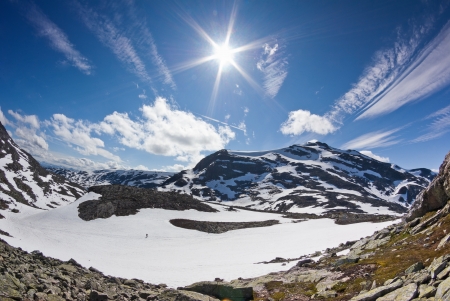1. Historical Overview of Backcountry Permit Systems
Backcountry permits are an essential part of exploring America’s wild places, especially in national parks and forests. But the way these permits are managed has changed a lot over the years. Understanding where these systems began helps explain why today’s reservation process looks the way it does.
Early Days: First-Come, First-Served
In the early days, getting a backcountry permit was simple and informal. Most parks operated on a first-come, first-served basis. Hikers would show up at a ranger station or park office, fill out a quick form, and head out on their adventure. This worked well when fewer people were visiting remote areas and demand was low.
Key Features of Early Permit Systems
| System Type | Description | Main Challenges |
|---|---|---|
| First-Come, First-Served | No advance reservations; permits issued in person upon arrival | Unpredictable availability; long wait times; congestion at popular trailheads |
| Self-Registration Boxes | Hikers registered at trailheads using paper forms | Lack of oversight; limited data for park management; potential for overcrowding |
The Shift to Formal Reservation Systems
As outdoor recreation boomed in the late 20th century, more people began exploring backcountry areas. Popular trails started seeing too many visitors at once, causing environmental damage and reducing the quality of the wilderness experience. Park managers realized they needed a better way to balance access with conservation goals.
Why Reservation Systems Became Necessary
- Increasing visitor numbers led to overcrowding on trails and campsites.
- Parks needed to protect sensitive environments from overuse.
- A formal system allowed fairer allocation of permits among hikers from all over the country.
The First Online Booking Experiments
The National Park Service and other agencies started experimenting with phone-in and mail-in reservation systems in the 1980s and 1990s. By the early 2000s, online reservation platforms emerged, letting people plan trips months in advance. This marked a major step forward—but also introduced new challenges like technical glitches and competition for limited spots.
2. Drivers Behind System Changes
The evolution of reservation systems for backcountry permits in the United States is shaped by several key drivers. Understanding these factors helps explain why national parks and wilderness areas have shifted from first-come, first-served systems to more advanced reservation platforms.
Increased Demand and Overcrowding
One of the main reasons for changing permit systems is the surge in popularity of outdoor recreation. Iconic places like Yosemite National Park, Grand Canyon National Park, and the Enchantments in Washington State have seen record numbers of visitors wanting to explore their backcountry trails. This increased demand has often led to overcrowding, which not only impacts the visitor experience but also puts pressure on fragile ecosystems.
| Wilderness Area | Challenges Faced | System Adjustments |
|---|---|---|
| Yosemite National Park | Overcrowding on Half Dome Trail | Lottery-based permit system introduced |
| Grand Canyon National Park | High demand for rim-to-rim hikes | Online reservations with rolling windows |
| The Enchantments (WA) | Limited campsites, environmental impact | Annual permit lottery system |
Conservation Needs
Protecting natural resources is a major concern for park managers. Overuse of trails and campsites can lead to soil erosion, water pollution, and harm to wildlife habitats. By limiting the number of permits issued and controlling where visitors can camp or travel, agencies like the National Park Service (NPS) and U.S. Forest Service help preserve the wilderness character of these special places.
Examples of Conservation Efforts:
- Zion National Park: Restricted access to The Subway and Angels Landing via permit lotteries to reduce trail erosion.
- Boundary Waters Canoe Area Wilderness: Daily entry quotas to protect water quality and solitude.
Technological Advancements
The rise of digital technology has made it possible to manage reservations more efficiently and fairly. Online platforms allow people from across the country to apply for permits without mailing paper forms or waiting in long lines at ranger stations. Systems such as Recreation.gov now handle reservations for many federal lands, offering real-time availability and automated lotteries.
Main Benefits of Modern Systems:
- Simplified application process for users nationwide
- Real-time tracking of available permits and quotas
- Automated random drawings for high-demand areas, promoting fairness
- Easier data collection for monitoring use and making future management decisions
Together, these drivers are continually shaping how reservation systems operate—helping balance access, enjoyment, and conservation across Americas treasured wild places.
![]()
3. Current Challenges in Reservation Systems
While reservation systems for backcountry permits have come a long way, they still face several hurdles that make it tough for everyone to enjoy America’s great outdoors. From tech headaches to fairness issues, let’s break down the main challenges people run into when trying to snag those highly sought-after permits.
Accessibility Barriers
Not everyone has equal access to these systems. Many permit reservations go live at set times—often early in the morning—making it hard for folks with inflexible jobs, different time zones, or limited internet access to compete. Plus, some systems are only available online, which can leave out people without reliable computers or smartphones.
Technological Limitations
Reservation websites are notorious for crashing or slowing down during high demand. Outdated platforms can lead to frozen screens and error messages, causing frustration and missed opportunities. Sometimes, even when everything works, the user experience isn’t friendly—making it confusing for new users to navigate the process.
Equity Concerns
The current first-come, first-served or lottery models often favor those with more resources and flexibility. This can create barriers for underrepresented groups who may not have the same ability to plan far in advance or adapt to sudden changes in reservation windows. Here’s a quick look at how equity concerns stack up:
| Challenge | Who’s Affected Most | Example |
|---|---|---|
| Lack of Internet Access | Rural residents, low-income families | No Wi-Fi or slow connections make online booking tough |
| Fixed Release Times | Shift workers, parents, international visitors | Permits drop at 10am PT; some can’t get online then |
| Complicated Interfaces | Older adults, new visitors | Difficult to understand multi-step sign-up processes |
Bot Usage for Popular Permits
Bots—automated computer programs—are becoming a big problem for popular backcountry spots like Yosemite’s Half Dome or The Wave in Arizona. These bots can snap up multiple permits in seconds before real people even get a chance, leading to unfair advantages for third-party resellers and commercial tour operators.
How Bots Impact Fairness:
- Bots buy up permits instantly after release.
- Scalpers resell them at inflated prices on secondary markets.
- Regular outdoor lovers get left out or pay much more than intended.
Visitor Dissatisfaction
The mix of technology troubles, equity issues, and bot activity leads many would-be visitors to feel frustrated and discouraged. Complaints about “never being able to win the lottery” or “the website crashing every time” are common on social media and outdoor forums.
Main Sources of Dissatisfaction:
- Poor website performance during high demand periods.
- Lack of transparency about odds and processes.
- The perception that only insiders or tech-savvy users succeed.
- Limited customer support when problems arise.
4. Innovative Solutions and Pilot Programs
As demand for backcountry permits has soared, land agencies across the U.S. have rolled out a number of creative solutions to make access fairer and more efficient. Here’s a look at some of the most promising innovations and pilot programs in recent years.
Lottery Systems: Leveling the Playing Field
To address the first-come, first-served rush that left many disappointed, several popular parks have adopted lottery systems. These help distribute permits more equitably, giving everyone—from local weekend warriors to cross-country travelers—a fair shot. For example:
| Park/Area | Lottery System Used | Main Benefit |
|---|---|---|
| Yosemite National Park | Preseason and daily lotteries for Half Dome permits | Reduces website crashes and frantic booking sessions |
| Boundary Waters Canoe Area Wilderness | Random-draw lottery for high-demand entry points | Prevents “reservation day” overloads and bots |
| Zion National Park | Seasonal lotteries for The Subway and Angels Landing hikes | Makes access less dependent on internet speed or luck |
Dynamic Pricing: Managing Demand Responsively
A few pilot programs are experimenting with dynamic pricing, where permit fees change based on demand—similar to airline tickets or concert seats. This approach aims to spread out visitor numbers, encouraging trips during less-crowded times while using higher prices to limit traffic during peak dates.
Key Benefits of Dynamic Pricing:
- Smoother Visitor Flow: Less crowding on trails and campsites.
- Revenue Boosts: Extra funds can support trail maintenance and ranger programs.
- More Options: Budget-minded hikers can choose off-peak slots at lower costs.
User-Friendly Digital Platforms: Easier Booking for All
The move toward centralized, mobile-friendly reservation sites—like Recreation.gov—has made it easier than ever to plan wilderness trips. Features like waitlists, real-time availability, and instant confirmations help reduce confusion and frustration. Yellowstone’s backcountry system is a good example; it now allows users to see campsite locations on interactive maps before booking.
Pilot Programs Worth Watching:
- Yosemite: Annual reviews of its permit process, including feedback surveys from applicants.
- Boundary Waters: Collaboration with outfitters to educate visitors on Leave No Trace principles before issuing permits.
- Zion: Adaptive release schedules, opening up additional spots in response to changing demand or weather events.
Toward a More Accessible Backcountry Experience
The evolution of reservation systems is ongoing, but these innovative approaches are helping to keep America’s wildest places open—and enjoyable—for everyone who loves them.
5. Looking Ahead: The Future of Backcountry Access
Digital Innovations on the Horizon
Backcountry permit systems have come a long way, but technology keeps pushing the boundaries. In the near future, expect to see even more parks adopting fully digital reservation platforms. Mobile apps may allow backpackers to book, modify, or cancel permits in real time—right from the trailhead or their living room. This means less paperwork and easier planning for everyone. Expanded digital access can make it easier for more people to enjoy America’s public lands while streamlining the process for park managers.
Real-Time Data Integration
Imagine checking campsite availability, trail conditions, or even wildfire alerts with just a few taps on your phone. Parks are exploring ways to integrate real-time data into reservation systems, so users get up-to-date info before and during their trips. This could help visitors make safer choices and reduce crowding on sensitive trails.
| Potential Feature | How It Helps Hikers |
|---|---|
| Mobile Reservations | Book permits on-the-go, reducing paperwork and wait times |
| Live Trail Updates | Stay informed about closures or hazards instantly |
| Interactive Maps | Easily plan routes and campsites visually |
| Push Notifications | Get alerts for weather changes or emergencies right away |
Shifting Policy Trends
The demand for backcountry adventures is rising fast, leading to new policies that aim to spread out visitors across more areas and seasons. Some parks are experimenting with lottery systems or staggered entry times to avoid overcrowding at popular spots. Others are focusing on equitable access, ensuring that underrepresented communities have fair opportunities to experience wild places.
The Balancing Act: Access vs. Conservation
Parks must juggle letting people in and protecting fragile environments. As technology makes it easier for more folks to snag permits, there’s growing pressure to ensure that access doesn’t harm the landscapes we love. Expect ongoing tweaks to quotas, fees, and education programs as land managers work to strike the right balance between sharing America’s public lands and keeping them healthy for future generations.


